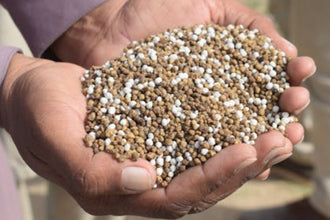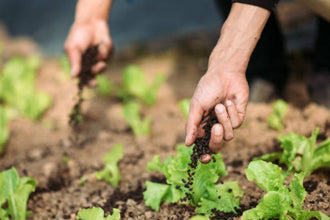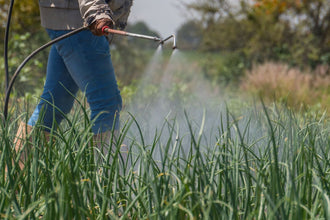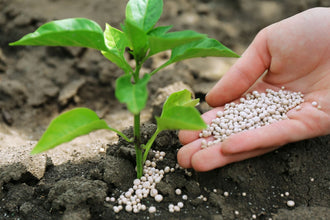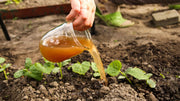
Fertilizer leaching wastes your money and hurts the environment. When you apply fertilizer to your garden, rain and watering can wash those nutrients right out of the soil. Instead of feeding your plants, these nutrients end up in groundwater, rivers, and lakes where they cause big problems.
Most people don't know their gardening habits contribute to water pollution. Every time nutrients wash away from your yard, they feed algae blooms that kill fish and make water unsafe to drink. But you can easily fix this problem with some simple changes to how you fertilize.
The best part? Stopping fertilizer leaching actually saves you money while protecting local waterways. Your plants get better nutrition, and you're not throwing fertilizer dollars down the drain.
How Fertilizer Leaching Actually Works
Water carries dissolved nutrients through your soil. When it rains or you water too much, fertilizer dissolves and moves down through the soil layers. Sandy soils let this nutrient-loaded water drain away fast. Clay soils hold water longer, but they still lose nutrients during heavy rains.
Timing makes everything worse. Spring fertilizer applications often get washed away by seasonal rains before your plants can even use them. Fall fertilizing on dormant grass is just as wasteful since sleeping plants can't absorb nutrients anyway.
Your soil type determines how fast you lose fertilizer. Sandy soils drain so quickly that nutrients barely have time to reach plant roots. You need to apply smaller amounts more often instead of dumping everything at once.
Soil Problems That Speed Up Leaching
Compacted soil creates runoff problems. When water can't soak in properly, it pools on top and then rushes away, taking your expensive fertilizer with it. This surface flow goes straight into storm drains and waterways.
Poor soil structure makes everything worse. Soils without enough organic matter can't hold water or nutrients. Your plants struggle to find the fertilizer you applied, so most of it just washes away.
Hard clay that doesn't drain well seems like it would prevent leaching. But during heavy rains, even clay soils get saturated and start losing nutrients through drainage.
Weather That Makes Leaching Worse
Spring rains hit right when most people fertilize. This timing couldn't be worse for keeping nutrients in your soil. Heavy downpours wash away fresh fertilizer applications before plants can use them.
Long dry spells followed by sudden storms cause major nutrient loss. Fertilizer salts build up during dry weather, then get flushed away all at once when the rains finally come.
Summer thunderstorms dump inches of water in minutes. Your soil can't absorb water that fast, so surface runoff carries fertilizer directly into storm systems.
Environmental Damage From Nutrient Runoff
Excess nitrogen in water creates toxic algae blooms that kill fish and make swimming dangerous. These green, slimy messes smell terrible and cost communities millions to clean up. Your local water treatment plant has to work harder and charge more because of this pollution.
Too much phosphorus ages lakes and ponds faster. Healthy water bodies turn into oxygen-poor dead zones that can't support fish or wildlife. Once this damage happens, it takes decades to fix.
Well water gets contaminated too. High nitrate levels cause serious health problems, especially for babies and pregnant women. Testing and treating a contaminated well costs thousands of dollars.
The damage spreads throughout entire ecosystems. Native aquatic plants die off as invasive algae takes over. Fish populations crash when oxygen levels drop. Wetlands lose their natural ability to filter water clean.

Why Organic Fertilizers Reduce Leaching Risk
Organic fertilizers work differently than synthetic ones. They release nutrients slowly as soil bacteria break them down. This gradual release matches how plants actually absorb food, so less gets wasted.
Natural fertilizers also improve your soil structure. They add organic matter that helps soil hold both water and nutrients better. Better soil means less fertilizer leaching and healthier plants.
Quality organic chicken manure has a balanced 4-2.5-2 NPK ratio that provides steady nutrition without overwhelming your soil with excess nitrogen. This moderate nutrient content works with natural processes instead of fighting them.
How Soil Biology Prevents Leaching
Beneficial bacteria and fungi love organic fertilizers. These tiny workers create sticky substances that glue soil particles together. Better soil structure slows down water movement and keeps nutrients where roots can reach them.
Mycorrhizal fungi act like extension cords for plant roots. They create underground networks that help plants find and absorb nutrients more efficiently. When plants can grab nutrients better, less fertilizer gets washed away.
Living soil biology cycles nutrients naturally. Microbes store nutrients in their bodies and release them slowly as plants need them. This biological nutrient bank prevents sudden losses during heavy rains.
Simple Ways to Prevent Fertilizer Leaching
You don't need expensive equipment or complicated systems to stop nutrient loss. Small changes in your fertilizing routine make a huge difference for both your garden and local water quality.
Split Your Applications
Instead of dumping all your fertilizer at once, break it into smaller doses:
-
Apply one-third in early spring when plants start growing
-
Add another third in mid-season during peak growth
-
Save the final third for late summer if needed
This approach gives plants steady nutrition while reducing leaching risk. Smaller amounts get absorbed more completely than large one-time applications.
Test Your Soil First
Soil testing shows what nutrients your plants actually need:
-
Most soils already have enough phosphorus
-
Over-fertilizing wastes money and harms water
-
Test every 2-3 years to track changes
-
Adjust fertilizer types based on results
Many extension offices offer cheap soil testing. Home test kits work fine for basic information. Either option beats guessing what your soil needs.
Time Applications Right
When you fertilize matters more than how much you use:
-
Wait until plants actively grow in spring
-
Avoid fertilizing dormant grass in fall
-
Don't fertilize right before predicted heavy rains
-
Choose calm, dry days for applications
Good timing keeps nutrients available when plants can use them. Poor timing guarantees waste and water pollution.
Building Soil That Holds Nutrients
Healthy soil acts like a sponge for water and nutrients. Instead of fighting leaching with more fertilizer, fix the underlying soil problems that cause nutrient loss.
Add Organic Matter Regularly
Compost improves everything about your soil:
-
Increases water-holding capacity
-
Provides slow-release nutrients
-
Feeds beneficial soil life
-
Improves drainage in clay soils
-
Helps sandy soils retain moisture
Even a thin layer of compost each year makes a big difference. Fallen leaves, grass clippings, and kitchen scraps all turn into valuable soil amendments.
Protect Soil Structure
Avoid walking on wet soil or tilling when conditions are soggy. Compaction destroys the pore spaces that hold water and nutrients. Once soil structure gets damaged, it takes years to rebuild naturally.
Cover crops between growing seasons capture leftover nutrients and prevent erosion. These living mulches break down to add organic matter while protecting soil during vulnerable periods.
Use Mulch Wisely
Organic mulches serve multiple purposes:
-
Reduce water evaporation
-
Prevent soil erosion
-
Break down slowly to feed soil
-
Moderate soil temperature
-
Suppress weeds that compete for nutrients
Apply 2-3 inches of mulch around plants, keeping it away from stems and trunks. Refresh mulch as it decomposes throughout the growing season.
Water Management That Prevents Runoff
How you manage water on your property directly affects fertilizer leaching. Smart water practices keep nutrients where plants can use them while protecting local waterways.
Install Simple Rain Gardens
Rain gardens are just low spots planted with water-loving plants. They capture runoff from roofs, driveways, and lawn areas before it reaches storm drains. Even small rain gardens make a difference.
Choose native plants that can handle both wet and dry conditions. Grasses, wildflowers, and shrubs all work well. The plants filter nutrients while creating attractive landscaping.
Improve Your Irrigation
Drip irrigation puts water right where plants need it. This targeted approach reduces both water waste and nutrient leaching. Soaker hoses work almost as well for much less money.
Water deeply but less often to encourage strong root growth. Shallow, frequent watering keeps nutrients in the top few inches where they're more likely to wash away.
Check soil moisture before watering. Stick your finger into the soil near plant roots. If it's still moist an inch down, wait another day or two.
Create Buffer Areas
Plant perennial grasses or wildflowers along slopes and near water features. These buffer strips trap nutrients and prevent erosion. They also provide habitat for beneficial insects and birds.
Native plants work best because they're adapted to local conditions. They need less water and fertilizer once established, reducing your maintenance workload.
Make Your Garden Part of the Solution
Preventing fertilizer leaching protects water quality while creating healthier, more productive gardens. You save money on wasted fertilizer while doing your part to protect local streams and groundwater.
Start with one or two changes this growing season. Test your soil to see what nutrients you actually need. Switch to organic fertilizers that release nutrients slowly. Time your applications to match plant growth rather than calendar dates.
These simple steps protect both your gardening budget and the environment. Your plants will be healthier, your soil will improve over time, and you'll know you're part of the solution instead of part of the problem.




